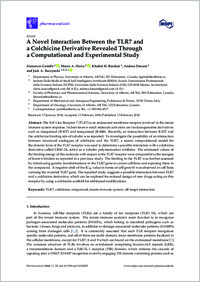A novel interaction between the TLR7 and a colchicine derivative revealed through a computational and experimental study
- Gentile, Francesco Department of Physics, University of Alberta, AB T6G 2E1 Edmonton, Canada
- Deriu, Marco A. Istituto Dalle Molle di studi sull'intelligenza artificiale (IDSIA), Facoltà di scienze informatiche, Università della Svizzera italiana, Svizzera
- Barakat, Khaled Faculty of Pharmacy and Pharmaceutical Sciences, University of Alberta, AB T6G 2H1 Edmonton, Canada
- Danani, Andrea Istituto Dalle Molle di studi sull'intelligenza artificiale (IDSIA), Facoltà di scienze informatiche, Università della Svizzera italiana, Svizzera
- Tuszynski, Jack Department of Physics, University of Alberta, AB T6G 2E1 Edmonton, Canada - Department of Mechanical and Aerospace Engineering, Politecnico di Torino, 10129 Torino, Italy - Department of Oncology, University of Alberta, AB T6G 1Z2 Edmonton, Canada
-
16.02.2018
Published in:
- Pharmaceuticals. - 2018, vol. 11, no. 1, p. 22
English
The Toll-Like Receptor 7 (TLR7) is an endosomal membrane receptor involved in the innate immune system response. Its best-known small molecule activators are imidazoquinoline derivatives such as imiquimod (R-837) and resiquimod (R-848). Recently, an interaction between R-837 and the colchicine binding site of tubulin was reported. To investigate the possibility of an interaction between structural analogues of colchicine and the TLR7, a recent computational model for the dimeric form of the TLR7 receptor was used to determine a possible interaction with a colchicine derivative called CR42-24, active as a tubulin polymerization inhibitor. The estimated values of the binding energy of this molecule with respect to the TLR7 receptor were comparable to the energies of known binders as reported in a previous study. The binding to the TLR7 was further assessed by introducing genetic transformations in the TLR7 gene in cancer cell lines and exposing them to the compound. A negative shift of the IC50 value in terms of cell growth was observed in cell lines carrying the mutated TLR7 gene. The reported study suggests a possible interaction between TLR7 and a colchicine derivative, which can be explored for rational design of new drugs acting on this receptor by using a colchicine scaffold for additional modifications.
- Language
-
- English
- Classification
- Biological sciences
- License
- Open access status
- gold
- Identifiers
-
- RERO DOC 328280
- DOI 10.3390/ph11010022
- ARK ark:/12658/srd1319108
- Persistent URL
- https://n2t.net/ark:/12658/srd1319108
Statistics
Document views: 163
File downloads:
- Texte intégral: 257
